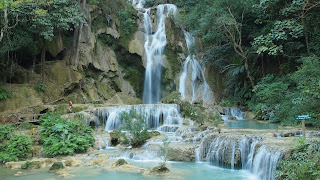The Plain
of Jars is a megalithic archaeological landscape in Laos, comprises thousands
of stone jars scattered around the upland valleys and the lower foothills of
the central plain of the Xieng Khouang. The jars are frequently arranged in
clusters ranging in number from one to several hundred. Various travelers that
make it to this remote corner of Laos will find fields of ancient stone jars.
Who put them there, and what were they for? Hence what purpose these stone jars
served and who constructed them remains a mystery? So far 90 jar sites have
been well recognized within the province of Xieng Khouang, and each site has
from one to 400 stone jars. However, jars are varying in height and diameter
amid 1m and 3m and are all hewn from rock. The Jar shape is alike cylindrical
with the bottom always wider than the top. Unidentified to most traveler’s,
thousands of stone urns dating back to the Iron Age (500 BC to AD 500) are
peppered over hundreds of square kilometers in the mountains surrounding
Phonsavan a lengthy detour from the typical transportation routes.
Due to jar
size and the adjacent bones, some archaeologists believe the urns were
prehistoric burial sites for an ancient civilization that travelled along an
elapsed overland trade route among the Mekong River and the Gulf of Tonkin. The
jars lie in clusters on the lower foot-slopes and mountain ridges of the hills
surrounding the central plateau and upland valleys. Therefore, a number of
quarry sites have been recorded, generally close to the jar sites. Five rock
types have been identified: sandstone, conglomerate, granite, limestone and
breccia. Others believe the urns were used as distilling vessels during the
early stages of funeral rites. So, a body would be placed inside and left to
decompose before being moved to a crematorium or secondary storage location and
after the corpse had fully decayed, the remains would be returned to the urn
and an additional fresh body would join it, repeating the same cycle.
This faith
is well supported by the traditional Southeast Asian mortuary practices used
for members of royalty. Moreover, Thai royals historically had their bodies
cremated several months after their death, with their body remains being moved
from urn to urn until the final day of incineration, in the faith that the soul
moves through a slow transformation, exiting the earth and entering the
mystical world. Furthermore, the rims on to each jar are believed to have
reinforced lids that would be placed on top until the body decomposed, adding
credit to this theory. However, the local’s inhabitants, on the other hand,
have more thrilling philosophies. Various local says the stone vessels were
shaped to brew powerful rice wine to rejoice the victory of a band of
mythological giants over their enemies; while the others say the jars held
whisky for a thirsty hulk that lived in the mountains above Phonsavan. However,
on the other side the truth is, no one knows the secret behind this ancient
mystery.
In the
early 1930s a French investigator concluded that the jars were related with
prehistoric burial practices, well excavation by Lao and Japanese
archaeologists in the intervening years has supported this interpretation with
the discovery of human remains, burial goods and ceramics around the jars. The
Plain of Jars is dated to the Iron Age and is one of the most significant
prehistoric sites in Southeast Asia. Since most of the jars have lip rims, it
is thought that the jars originally supported lids, although few stone lids
have been recorded; this may propose that the bulk of lids were fashioned from
unpreserved materials. Stone lids with animal carvings have been found at few
sites such as Ban Phakeo.
The
bas-relief carvings are supposed to portray monkeys, tigers and frog, though no
in situ lid has ever been found. Walking through the fields, you can spot
dozens of red and white markers placed prudently on the ground signs of a far
more disturbing secret amid the mystery. Thus, “Phonsavan” was located on a
flight path for United States fighter jets during the Vietnam War and became
the unauthorized dumping ground for 270 million cluster bombs, manufacture it
the world’s most heavily bombed place per capita. More than 80 million of these
bombs failed to detonate upon landing, treacherously polluting the area and
creating much of the land surrounding the Plain of Jars unusable.
Well,
tourists to the site must stay close to the marked, cleared zones, because
answers to the mystery were long gone; only spider webs and still water
remained. Time and war may have removed any chance we have of understanding who
built these marvels and why. The Lao PDR government and “NZAID” built a
visitors center that was opened on 13 August 2013 at the Plain of Jars Site 1
and it is at the bottom of a hill 200m before a car park. The center provides
English language information panels on the history of the Plain of Jars
culture, as well as its modern history during the 1964 to 1975 conflict.
Moreover, Lao PDR government is considering applying for status as a UNESCO
World Heritage site for the Plain of Jars.


































































